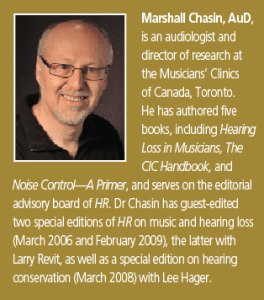Back to Basics | December 2014 Hearing Review
By Marshall Chasin, AuD

Records, from Edison to the 45. Recording of music began in 1878 with the Edison Phonograph. In 1948, Columbia Records came out with the 12″ 33 1/3 rpm record, and 1949 saw the development of the inexpensive RCA Victor 7″ 45 rpm record. In 1957, the Ampex 8-track recorder was invented (along with a vast assortment of matches, candy wrappers, and other wedge-shaped items you’d have to stick underneath them for the tapes to play properly). Philips, and later Sony, came out with the compact disk (CD) in 1985. The MP3 format was introduced in 1990, even though the portable MP3-player did not become avail- able until 1998.
After the release of the Edison Phonograph, people could listen to their favorite music in the comfort of their own living rooms (and I suppose horse-drawn carriages, but I would imagine that the bumpiness of the carriage prevented them from enjoying the inevitable intermittent sound of the music). Partly due to the fact that the condenser microphone was still 40 years off (Wente 1920), the Edison Phonograph had a very restrictive dynamic range. As a partial result of this limitation, performance inventions had to be incorporated into the recorded music, such as violin “vibrato,” to ensure that the instrument was heard above the harmony of the music and to replace some of the face-to-face contact that was lost in a recording.
With the advent of records—first the 78 rpm and later 33 1/3 and 45 rpm records—the maximum volume was limited by the height of the grooves etched into the record. High volume recordings were simply not possible because the playback needle would physically pop out of the groove. Additionally, high-powered amplifiers could not transduce high levels without some audible distortion.
Cassettes and Dolby. The cassette form of media, introduced in 1963, improved things in this respect. However, all forms of media have an internal noise floor. Cassette noise is inherently broadband and can easily be heard during quiet portions and in between tracks.
It was 13 years before Dolby came out with a noise reduction system in 1976 to minimize this audible tape noise. An entire generation of listeners grew up hearing tape noise, and initially its absence was not liked. Early Dolby reviews were far from stellar, but eventually Dolby helped to retune the listening ear.
Dolby is a really neat system. Although it used filters, compressors, and amplifiers, the input spectrum was identical to the output spectrum, except that the (high frequency) tape noise was removed. This could not be said about some other noise reduction systems of the time, since these tended to alter the shape of the frequency spectra, especially in the higher frequency region where tape noise was the most audible.
The MP3. A minor step back occurred in 1990 with the introduction of the MP3 audio format. The MP3 format got rid of the tape noise (by getting rid of the tape), allowed distortion free recording over a wider range of frequencies, and was not limited by the material of media (ie, mylar and chromium oxide metal-based tapes). And it also introduced significant compression into the recordings.
Compression is used all of the time with hard-of-hearing people and hearing aids. On the surface, compression sounds like a great innovation; it increases the output for soft sounds and reduces the output for overly loud sounds. Compression assures that the recorded music is within the dynamic range of the recording media. No longer are the softer elements of music inaudible, and no longer are the percussive crashes of cymbals beyond the capability of the MP3 player.
So what’s wrong with laws stipulating recorded music only? Compression, in doing these wonderful things, also alters the loudness dynamic cues that were intended by the performing musicians and composers. Music is “squished” into a dynamic range that is optimal for the MP3 media—and not necessarily for the engaged listener or musician.
Today, this squishing of music into a dynamic range is one of the biggest complaints about MP3 and other digital file formats. Radio stations have jumped on the MP3 band- wagon, and even my favorite local jazz station “compresses the hell out of music”—a direct quote from a local musician.
I understand the need for compression with modern formats, but in some sense we were better off in the golden years of music recording (1976-1990). The recorded sound between 1976 (advent of Dolby) and 1990 (the period just before the MP3 format) were perhaps the closest we ever had to minimizing the difference between live music and recorded music.
Ease of volume control (recorded music) is one side of the noise regulation coin, but the other is a substandard level of music. Live music does not need to be compressed. Many of the things that a performing artist needs to do on a recording are arbitrary and a direct reflection of the inability to optimally transduce the recorded music. To enshroud a bylaw or city noise ordinance in terms of live versus recorded music demonstrates a poor understanding of music and its effects.
Citation for this article: Chasin M. Live vs Recorded Music. Hearing Review. 2014;21(12):12.





